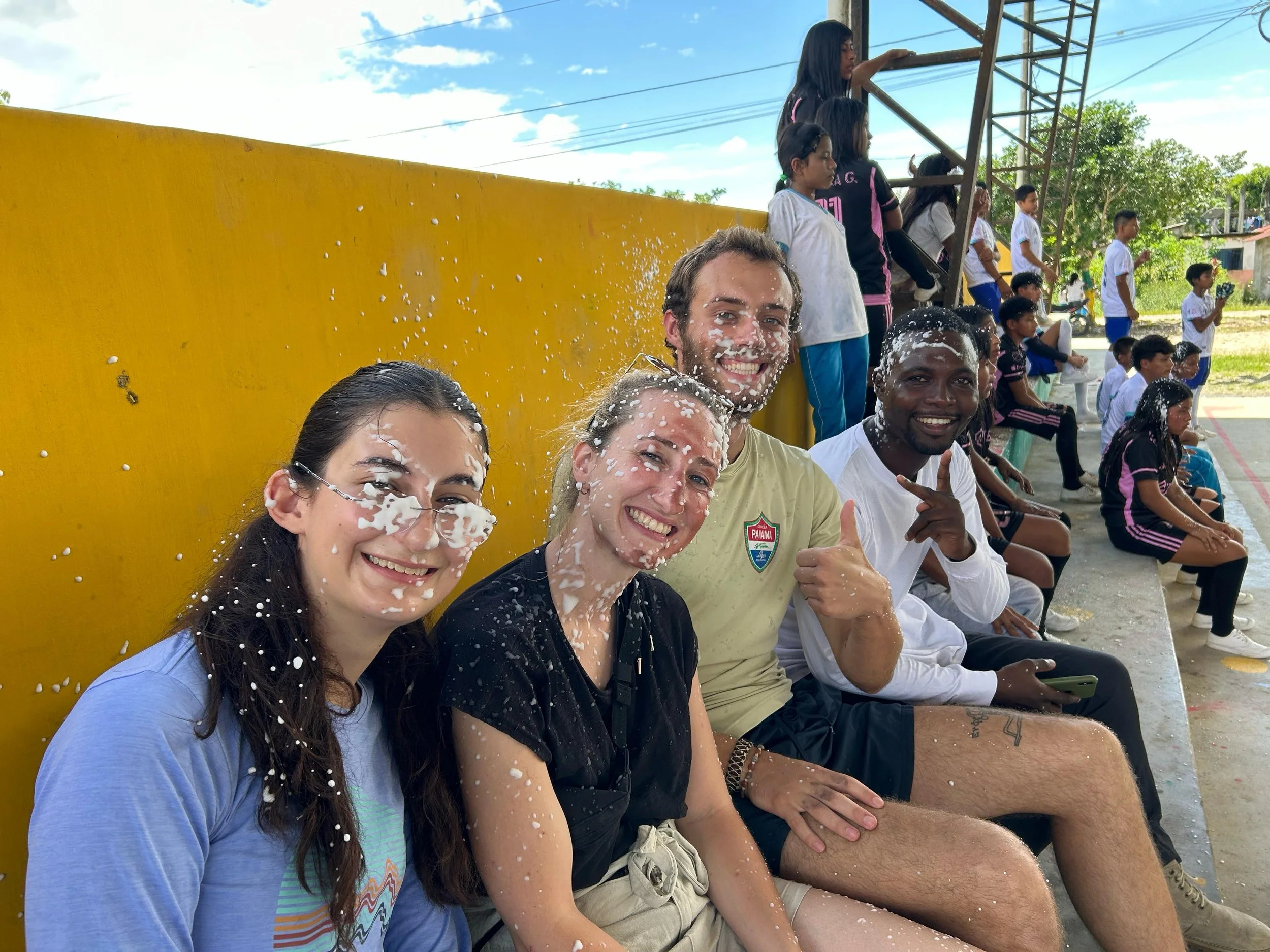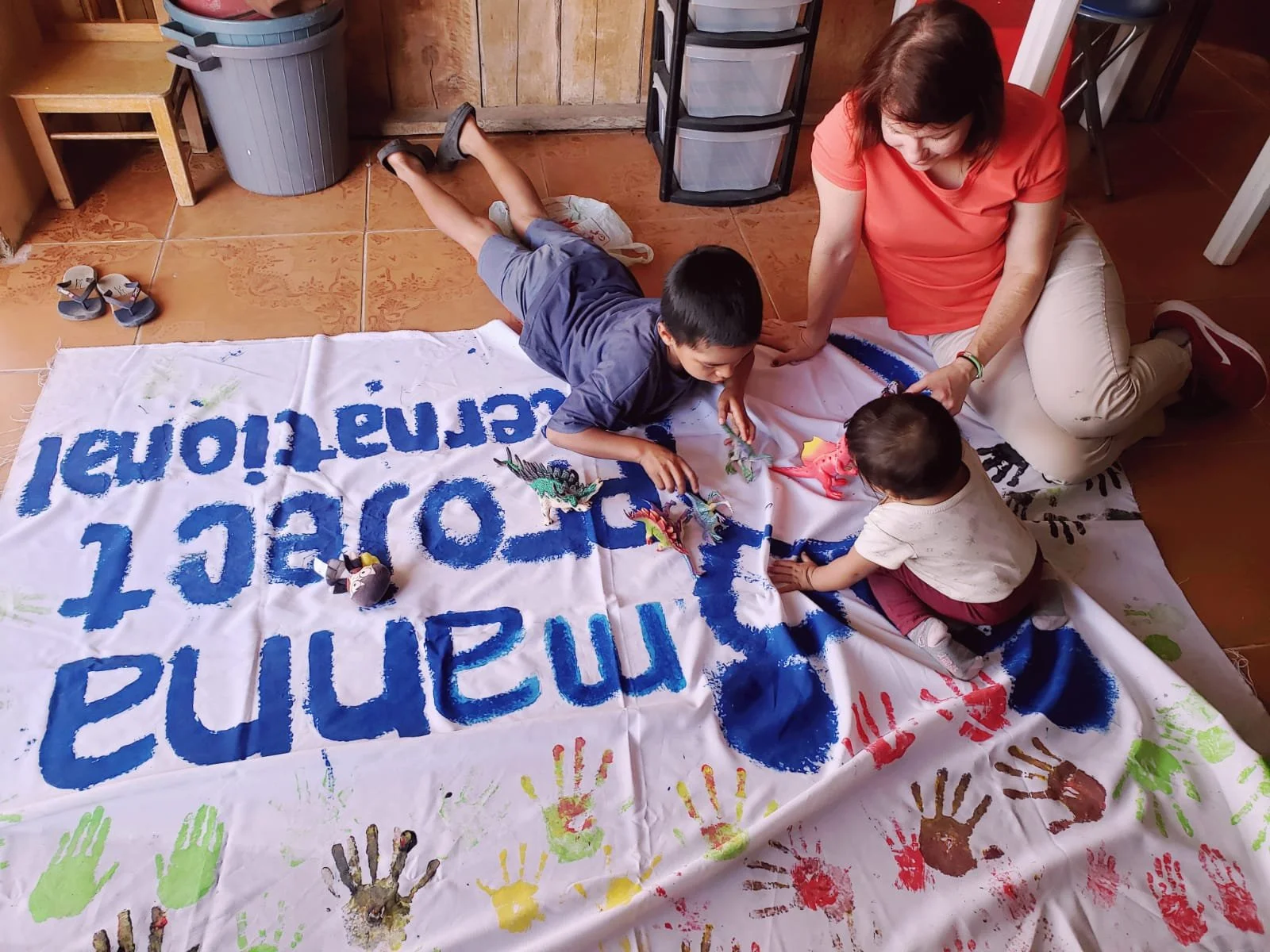Antorcha de Vida
Antorcha de Vida is a rehabilitation center and educational facility for special needs children, located right down the street from our house in Sangolquí. The directora Nancy is a wonderful, hardworking woman with a huge heart. Noel introduced me to Nancy my first week in the Manna House in an effort to keep up our relationship with this wonderful foundation. This woman was so sweet, welcoming, and passionate about her cause that I immediately started brainstorming ways we could get more involved in what they were doing. She took us on a tour of the facilities and showed us the beautiful organic gardens that are planted and maintained by the children, their mothers, and the women who work for the foundation. Nicole and I decided to expand our Agriculture Program to volunteer once a week during their agricultural workshops. We are only able to give them an hour and a half of our time on Thursdays, but we are learning a ton about organic gardening. The women are so sweet and appreciative, and working with the niños has been an amazing experience, as well as a lesson in patience.
The kids at Antorcha de Vida have a variety of mental and physical handicaps, which they work on through different types of therapy. We spend the morning helping them pull weeds, water the plants (and often ourselves in the process), and look after the gardens. Keeping the kids occupied and interested in the work can be a difficult task, and our extra sets of hands are definitely useful. One of our favorite kids, Michael, has a problem with his legs and needs to hold onto someone for support when he’s walking. He is in the process of learning to walk on his own, but sometimes gets too excited and needs to be reminded to slow down and take it one step at a time. The kids really seem to enjoy working in the gardens, and love to show us the handfuls of weeds they pull.
My favorite part of the experience is listening to the Ingeniero tell stories (often the same ones) about the political history of Ecuador, the medicinal properties of eggplant, and his grandsons in Miami. This 80-something year old engineer stumbled upon Antorcha de Vida one day, and has been sharing his agricultural expertise with them ever since. His secret formula named MBO (after him of course) is an organic, chemical free, fertilizer that keeps diseases and pests away from the crops. This mixture has done wonders for the plants there, and the women continue to pester the Ingeniero for his recipe. Unfortunately for them, the secret is just for him and his nietos in Miami.
The Ingeniero can recite the same love poem in Quechua, Spanish, and French… but can’t remember our names. He affectionately refers to us as the Señoritas Extranjeras and after several failed attempts to correct him; we have decided to let that one slide. Listening to his stories is an incredible way to learn about the country, and about organic gardening. This man knows everything there is to know about agriculture and herbal remedies. So whether we are mixing secret organic formulas with the Ingeniero, or just walking back and forth with Michael, volunteering with Antorcha is always a beautiful experience.
El Feriado (The Holiday)
While the month of November brings colder weather and the beginning of the holiday season for everyone Stateside, the new month heralds the arrival of a different holiday for Ecuadorians. While the temperature remains a perfect 65 to 70 degrees most days, many Ecuadorians have been busy making plans for what to do with a four- (or more-) day weekend in honor of Día de los Difuntos, which was officially celebrated November 2nd. Similar to Day of the Dead in Mexico, el Día de los Difuntos honors the souls of family members who have passed away with a celebration of cooking and graveside remembrance. At the Manna house, we were fortunate to enjoy two particular Ecuadorian traditions: colada morada, a hearty drink made from berries similar to blueberries, and guagua de pan, which are baked creations shaped like children. Check out pictures below that Heather posted from the Manna house get-together.
Aside from sampling cultural fare and learning about Ecuadorian traditions, the four-day weekend provided the opportunity for PDs to travel and explore Ecuador. One group of PDs, including Emily, Charlie, and country director Darcy made a long trip to the Amazon rainforest in “el oriente” to see its exotic biodiversity. Another group of PDs, including Watkins, Heather, Nicole, and Rachel, chose to stay behind and explore places near Sangolquí. With the accompaniment and guidance of a couple of our adult English students, we discovered a former lime mine in the heart of traditional Quechua land and also hiked to “la gran cascada” of Rio Pita, which is the highest waterfall in Ecuador.

On the first day of the Sangolquí-based adventurers’ vacation, the group of PDs accompanied English student Nadia Torres on a work-related trip. Nadia works as a photographer and journalist, and is helping write a book about the history of Sangolquí. Our trip began with a bus ride along dirt roads to a small town called Tolóntag, near where we hoped to find a mine from which lime (cal) was taken that was used in the construction of the plaza of Sangolquí. Nadia, being a journalist, procured us permission to visit the mine and some general directions from the town’s mayor. While Nadia worked her magic, the PDs made friends with some locals and were gifted with maqueños, a kind of plantain with a reddish peel and peach-colored fruit. In our casual conversation, we were told that children from Tolóntag traveled an hour each way to school every day. We also noticed that the Spanish spoken in this small town differed markedly in pronunciation from what we’re used to, a difference Nadia attributed to the Quechua tradition.

With permission, vague directions, and a hired camioneta (pick-up truck), we embarked down a rocky road until the driver bade us farewell and we began walking. We enjoyed good views of hills and volcanoes, and after a while encountered a family working a field of crops near the road. After pleasantries, the adults had their children guide us to the site of the former mine, where we had lunch and took pictures, and laughed at our guides’ antics. The kids were intrigued by our accents and happily showed us the former mine, which is now a thermal pool of water, and other sites near their farm. We ended our trip that day by returning to Sangolquí and having ice cream at an heladería next to the plaza of Sangolquí.


Long Weekend



The Year of the Dog
Hey everyone, I turn this week's blog over to Profe Nicole for a Children's Art update:
Children’s Art is one of our programs that operates almost entirely off of in-kind donations. To date the art program has not spent a dime for any of our classes. Each week, Taylor and I spend time researching traditional and popular forms of art from various countries; we then take these projects and themes and adapt them into something we can do with what we have: a finite art supply shelf and the short attention span of 5-10 year olds.
We chose to start this quarter by working our way through different countries in Asia. At the beginning of each week I start getting the question, “Profe, qué vamos a hacer en la clase de arte?”, but our eager students never get the answer they want…Taylor and I usually claim that we haven’t the slightest idea or turn the question around on them and so they continue asking us and every other profe in the vicinity. Each class starts with a slideshow about the country we are studying, which often contains more pictures then facts – appealing to that attention span! – but it’s always fun to hear them pronounce the names of the capitals, cities, and buildings, try to claim they can read Hindi, and see the information they retain. After explaining the Chinese calendar and animal for each year, we figured out who was born under which animal; Matias was so excited to find out that he was born in the year of the dog that he continues to include drawings of dogs in every other art project we’ve done, constantly reminding us that he was born “en el día del perro” – close enough!
This past week guest profe Charlie and I mixed things up a bit and got the kids out of the classroom and doing a project that for once they couldn’t take home. The country of the week was India, and I had previously asked help from a friend in the states, Dolly, whose family is from India. After struggling to narrow down the incredible and extensive list of cultural traditions and ideas she gave me, we decided to focus on the Peacock – a sacred bird in Indian culture – and traditional chalk drawings. Despite the typical rainy season schedule that called for rain at 3-4 in the afternoon, the weather was perfect for an outside art project. Some kids used designs and peacock pictures I had printed out, but most of them just went at it…working together and using their hands, elbows, and feet to mix colors and color our sidewalk nothing short of awesome.
After class I came back upstairs and immediately told Heather that we have to add sidewalk chalk to the online wish list. If our students had half as much fun as I did, we might be out there everyday!












